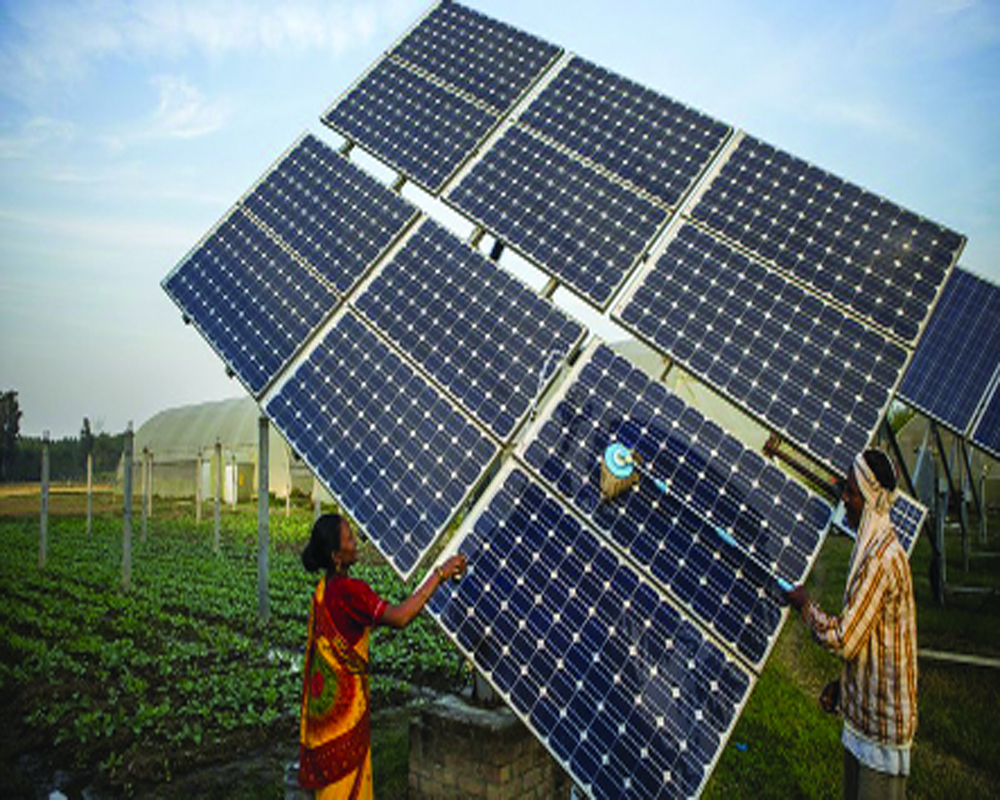Trees can absorb four tons of CO2 over the course of 40 years. A forest is considered a carbon sink if it absorbs more carbon than it emits
India is the world's third largest producer of renewable energy and the third largest consumer of electricity. As the country advances, the per capita consumption of electricity is likely to rise sharply. Consumption of coal, gas and crude oil is also expected to increase. At present, solar and wind produce less than 13 per cent of the total energy consumed and the rest comes from coal, petroleum, nuclear, etc. Burning of coal, natural gas, and oil to generate electricity and heat is the leading cause of greenhouse gas emissions globally.
Would it be possible to generate all the electricity we need without emitting additional greenhouse gases?
India emits 83 per cent of greenhouse gases. Additionally, India's population growth will intensify the demand for food, which in turn will necessitate more urea and irrigation, and using the Haber-Bosch process to produce urea will exacerbate greenhouse gas emissions. Therefore, it is necessary to switch to less CO2-intensive energy. The developed nations like the US and Western Europe have the potential to reduce greenhouse gas emissions through appropriate measures and specific innovations because their research and development budgets are relatively large for this purpose. Obtaining carbon-free electricity will be a huge challenge for India because to achieve zero emissions, all of our electricity must come from non-emitting sources. Solar, wind, hydroelectric, biomass, and geothermal power can provide energy without causing global warming.
While natural gas plants are running, they need to purchase fuel and the price of fossil fuels does not reflect the cost of climate change in terms of greenhouse gas emissions. Solar and wind energy are intermittent sources. The maximum conversion capacity of solar energy is only 33 per cent. They cannot generate electricity 24 hours a day, so their storage and generation costs should also be considered. Batteries used in off-grid solar systems can be charged during the day and used during the night. It is a reasonable solution for using solar power throughout the day, but it is also quite expensive due to the costs associated with the battery and its life, which will determine how much it adds to the electricity bill and the public exchequer.
Solar power generation is significantly less in winter than in summer. Solar power and wind energy generation is totally dependent on natural circumstances. Even in bright sunshine and strong winds, production will always be less than the installed capacity due to intermittent shutdowns caused by maintenance. To collect as much sunlight as possible, we need a large number of solar panels that take up a lot of space, and some roofs are not big enough to accommodate them, so space is also an issue. Location is also increasingly important in solar energy. Our installation needs to be increased many times compared to the current one.
Even though nuclear power could be a solution, it is risky and capital intensive.
The main reason why zero-carbon electricity is so expensive is intermittency. Because of this, the state is aiming to generate more renewable electricity by combining solar and wind power with other options like gas-powered plants, which is a necessity for cities and towns. It can be argued that the grid -a single connected network is the solution, but in practice, this is not feasible, at least in the near future.
To use renewable energy more efficiently and generate carbon-free energy, we must invest more in research and development. Furthermore, issues such as widespread poverty alleviation, education, health, clean drinking water, water for sanitation and job creation require more money to be diverted to address these issues, which in turn can adversely affect investment in research and development. Even if we take into account the government's efforts towards clean energy, new innovations will be required to remove its impediments. Diffusion of innovations requires R&D expertise and also a long period of persuasion, decision-making, and implementation that will take a considerable amount of time.
Therefore, conservation, afforestation and sustainable forestry practices are also the most efficient and cost-effective ways to combat carbon emissions.
Trees can absorb four tons of CO2 over the course of 40 years. A forest is considered a carbon sink if it absorbs more carbon from the atmosphere than it emits. Photosynthesis absorbs carbon from the atmosphere. It is then deposited in forest biomass (such as trunks, branches, roots and leaves), in dead organic matter (litter), and in soil and microorganisms. This process of carbon absorption and deposition is known as carbon sequestration.
(The writer is a former IFS officer. The views expressed are personal.)


























